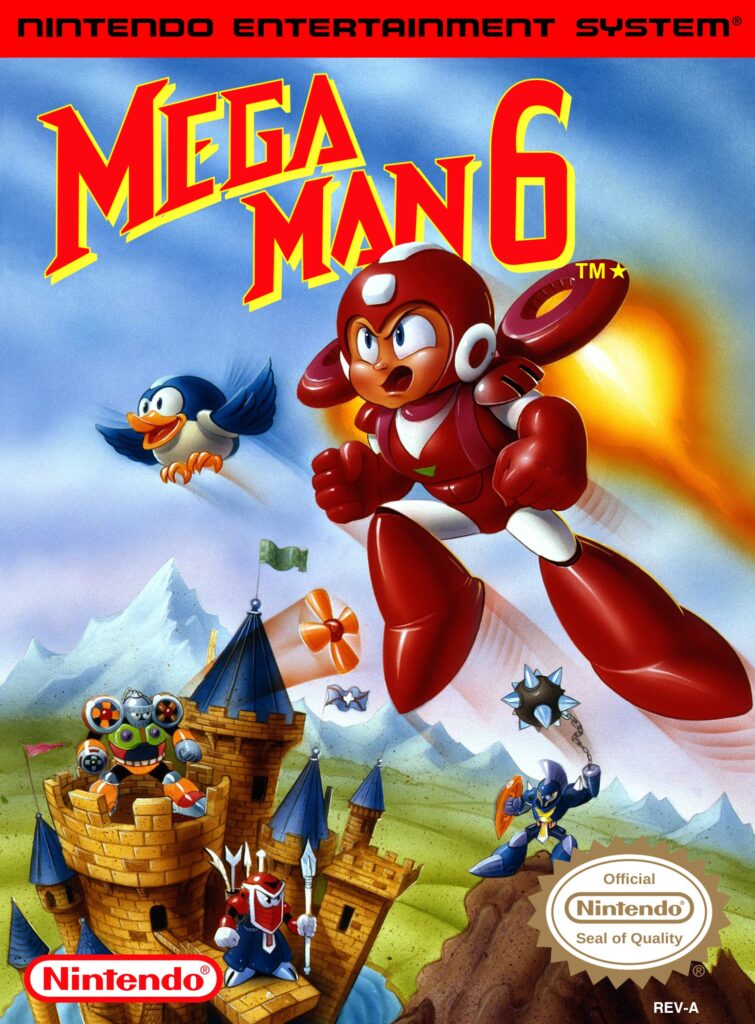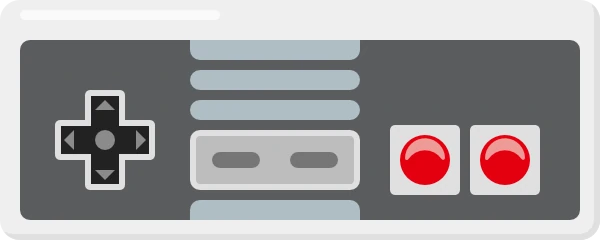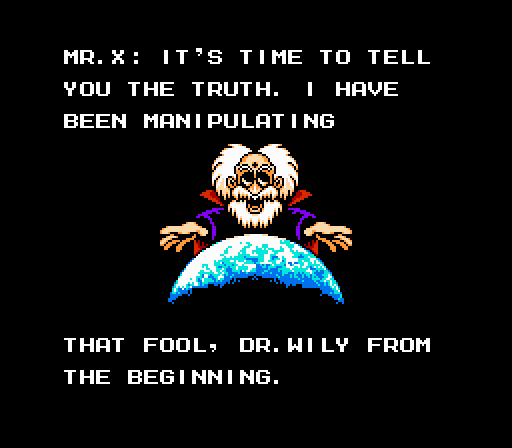A fond farewell.


PLAYERS: 1
PUBLISHER: Nintendo
DEVELOPER: Capcom
GENRE: Action
RELEASE DATE: Between December 1993 and March 1994
Mega Man 6 didn’t just mark the end of the series on the NES: it marked the end of the NES era, period. Very few games would release after it, and despite being a part of a prominent series, many gamers chose to ignore it for its 16-bit cousin, the fantastic Mega Man X. Reports vary about when 6 actually came out. Wikipedia and GameFAQS both list its release date around March 1994, while NintendoAge lists the date around December 1993. Though I personally remember seeing – and renting – the game in a Blockbuster in ’93, it doesn’t really matter. Mega Man 6 was one of the last NES games to come out in the States, and only thanks to Nintendo’s own efforts; for some unknown reason (I tried hunting down information, to no avail), Capcom had decided not to publish it in America.
It’s really a shame that this game was ignored, though I’m not at all surprised that it was. Even if you were a Mega Fan back in the early Nineties, you were inevitably experiencing burnout and a sense that Capcom should have stopped, possibly with Mega Man 3 or Mega Man 4. While 6 is no masterpiece, it is certainly on-par with 4 and a great deal more rewarding than the travesty that was Mega Man 5. Capcom saved the majority of its developing mojo for Mega Man X, but Mega Man 6 still deserves to be played.
“IN THE YEAR 200X A.D…”
Like the previous entries, Mega Man 6 tries to add a couple new features to keep the formula from becoming too stale. Instead of calling out Rush whenever you want to jump higher, swim, or fly across a gap of spikes, now Rush adapts to Mega Man’s body. Rush’s powers allow Mega Man to punch through cracked blocks or fly with a jet pack. The plus side of this is that Mega Man no longer has to refuel the “Jet” or “Pow” powers; plus his look of cute determination as he flies upwards in his jet-pack is priceless. The down side of this is a severe lack of Rush. He’s seen in the transformation screen when you switch between the Rush forms, and that’s it. Beat, however, makes a triumphant or lackluster return, depending on your affinity for the character and his amazing ability to destroy burgeoning world conquerors. In order to get him, you have to beat the “real” bosses in the stages of Yamato Man, Tomahawk Man, Centaur Man, and Knight Man. In these stages, there are two branching paths: one will take you to the clone boss, and one to the “real” boss. Obviously, it takes a little more effort to get to the real boss, but Beat’s not as necessary to 6 as he was to 5 – if you get him, cool, but if not, you won’t suffer. Another new and neat little feature are in-game stats that appear whenever you choose a boss. There’s the typical height-weight information, but it also gives the bosses attack power and defence power, along with their title; for example, “Blizzard Man: Master of Snow.” Nothing too fancy, but it’s a nice change.
The story treats Mega Man – and his fans – like complete jackasses. While I like the idea of a robot world tournament because it’s a blatant callback to Capcom’s own Street Fighter II and it makes for more interesting robot bosses, “Mr. X,” the supposed bad guy, isn’t fooling anyone. I can’t believe that Mega Man bought Mr. X’s story about being in control of Wily from the beginning, when he looks exactly like Wily with a beard (equally ludicrous is the picture of “Mr. X” smiling, with his hands above the world). True, nobody is playing Mega Man 6 for a gripping soap-opera story, with Pynchon-esque labyrinthine plot twists, but some creativity could have helped 6‘s reputation.
“COME AND FACE MY POWER, MEGAMAN!!”
I’ll probably get flack for saying this, but this particular boss set contains some of my very favorite bosses out of the six NES entries. I’ve always been an advocate for the more ridiculous the design, the more profound the impact (except for Charge Man, who deserves nothing less than a lifetime junkyard sentence). Say hello to:
FLAME MAN, BLIZZARD MAN, PLANT MAN, TOMAHAWK MAN
YAMATO MAN, KNIGHT MAN, CENTAUR MAN, WIND MAN
Since all of the bosses came together around the premise of a world robot tournament, each boss is from a different (and, true to Capcom form, stereotypically represented) locale. Flame Man is from Saudi Arabia (though with that turban on his head, he represents the Middle East), Blizzard Man is from Canada, Plant Man is from Brazil, Tomahawk Man is from the United States, Yamato Man is from Japan, Knight Man is from England, Centaur Man is from Greece, and Wind Man is from China (?!).
If you’ve ever played a Mega Man game, you know what to do: run from right to left, shoot robotic enemies, avoid spikes and drops, and defeat the boss. It’s precarious platforming at its palpitating finest. Here are some off-hand observations/quirky things I noticed whilst traversing the stages of Mega Man VI.
- There are oil pits in Flame Man’s stage and there are also enemies that spit out little flames from the top of their head. The oil itself won’t hurt you, but should the flames touch the oil, the entire pit will go up in flames. It’s a well-done graphical effect that displays just how well Capcom knew the Nintendo’s architecture.
- There are timed exploding platforms in Blizzard Man’s stage. I’m surprised it took Capcom six tries to mesh both explosions and platforms.
- Mega Man 6 loves spikes more than any of the Mega Man games. Said torrid love affair kicks off in Blizzard Man’s stage, where Mega Man is on the constantly moving submarine. Jump too high and spikes. Sink with the ship and spikes. More spike-on-robot action to come.
- Plant Man’s stage is uneventful, until around halfway through. Long-time Mega Fans know what I’m rappin’: a combination of non-stop bouncing coils, floating platforms, robotic fish that try to snap your trousers from below, insectoid flying creatures from above, and an ever-present watery grave. It only gets harder too! As you go along, enemies appear on the coils ahead of you, bouncing with reckless abandon, impeding your progress, and firing projectiles at you. Until I figured out that you hold down ‘A’ to bounce high, this part was torture. Possibly one of the hardest platforming sections of any Mega Man game.
- The dispensers of Metools in Tomahawk Man’s stage are awesome. Look at how they’re piled on top of each other!
- Tomahawk Man’s stage is called “Restricted Area” and, judging by the desert backgrounds and the egregious cowboy robots, is set in the Western United States. As if naming a character Tomahawk Man wasn’t enough to imply that, yes, he’s supposed to be Native American.
- Not only is Yamato Man the “Master of Spear,” his fortress is impregnable. Don’t even try impregnating it because you won’t get anywhere.
- The ancient Japanese figure atop a toad in Yamato Man’s stage definitely goes down as one of the strangest mid-bosses in Mega Man history.
- I like the castle interior theme of Knight Man’s stage, but the two outside backgrounds – silhouetted trees atop a red sky, and a dark, looming storm – are 8-bit graphical wonders – plus, they’re reminiscent of Castlevania, always a good thing.
- More spikes in Knight Man’s stage, this time in the form of a descending ceiling.
- Centaur Man’s stage fulfills the “one water stage per Mega Man game.” As usual, gravity is reduced underwater and spikes are constant.
- Centaur Man has to be one of the biggest – and most undeniably awesome-to-the-max – bosses in the series.
- According to Mega Man Wikia, Knight Man and Wind Man are the only two bosses ever designed by North Americans. Not exactly sure how Wind Man got picked, but Knight Man’s great. Good show, Yanks!
- Wind Man might have the most boring stage of the lot. Fitting as his concept/design is basically Air Man Redux.
MR. X’S CASTLE
STAGE 1 – STAGE 2 – STAGE 3 – STAGE 4
Mr. X foresaw that Mega Man would come after him and decided to build a fortress with about four stages or so. At this point, I wish I could have sat down with Mega Man – had some coffee, a biscotti, and some small talk. I’d ask, “Doesn’t this remind you of anyone, Mega Man? Shouldn’t you be clued in by now?” Mega Man says nothing as he wrestles with the stale biscotti. “Well, just keep in mind that this is fortress #1, alright? Very good,” I say, sipping my coffee as loudly as possible. It doesn’t really matter why Wily tries to hide his identity anymore. He’s a tenacious robot-making/enslaving doctor and that’s that.
- The “Mr. X Fortress Theme” that spans all four stages is incredibly evocative of previous somber stage themes. Yuko Takehara, the composer, did a good job throughout, but this particular piece is as fantastic as any Mega Man theme from Mega Man 2 or 3
- The blue city background in Stage 1 connects so well with the music that I wish Mega Man could have stayed outside and not gone into the fortress. Then again, I’ve come to realize over the course of six games that I always appreciate when Mega Man’s outside of an enclosed fortress. Fortresses all begin to look the same, but Capcom’s artists do wonder with natural scenes.
- Stage 2 is incredibly short, but between the abundance of spikes, obnoxious bouncing skulls, and Metools, it will feel a lot longer.
- Stage 3 has the best boss: a tiny Metool in an oversized novelty robot dozer.
- Beat’s obnoxious cousins hang out in Stage 4 and travel through long yellow tubes. They hate Beat, and consequently, they dive bomb Mega Man.
- Mr. X is incredibly easy to beat. He’s inside of a Chain Robot with spikes on the side and he swings back and forth from the ceiling. Just avoid his energy blasts on the ground and pump him full of Flame Blast. He transforms back into Wily after you defeat him, without even acknowledging that he was using a disguise.
“LET THE FINAL BATTLE BEGIN!”
DR. WILY’S CASTLE
- You’ll be using your Jetpack a lot in Stage 1. One particularly nasty section has you falling quickly amidst lines of spikes. Mega Man’s dealt with similar situations in previous games, but it’s nice to have an extra boost with the pack, if you need it.
- The dinosaur boss in Stage 1 is so Nineties.
- There’s some suggestive-looking snow that dominates all of Stage 2. Also, bubblegum pink returns as a color that no one asked for.
- Stage 3 is predominantly a “fight the boss all over again because we know you love to do that” stage, but there’s one particularly devious section prior to that where you’re stuck between two walls of spikes, and an enemy fan alternates between sucking you towards itself (and spikes) or blowing you away from itself (and spikes).
- Wily has three forms in the last stage, all of which are incredibly easy. The first is a Skull Smasher, the second form is the Skull Smasher with a visible Wily, and the third is Wily in his UFO. It’s sad that he tries so hard to conquer the world year after year – investing billions of dollars into robot schematics, dual fortresses, hidden identities – and yet Mega Man continually takes him down without fail.
“MY SCHEME FOR WORLD DOMINATION HAS FAILD!”
According to the Capcom Times, Mega Man finally hog-ties Dr. Wily and puts him in jail. At long last – after six years of up-and-down, will Wily conquer the world or not – we can all sleep soundly knowing that Mega Man 7‘s at least a couple years down the road.
Mega Man 6 does exactly what it needs to do: right the wrongs of Mega Man 5 and bring closure to the NES saga. Compared to 5, the gameplay is more balanced, the bosses and their weapons more unique, if not wholly bizarre, and the music, while not a complete success, captures the Mega Man essence more often than not. It would have been nice to have one more classic Mega Man adventure on the NES, but who can blame Capcom for pouring the majority of their resources into Mega Man X? Mega Man 6 is a solid platforming experience and a worthy addition to the series.
B
As always, a million-and-one thanks go to GameFAQs.com for helping me through the tough times, Megamanwikia.com for an amazing wealth of knowledge about all things Mega, and MegaManNG’s Youtube videos for being so well-organized and accessible.
Thanks also to you the readers for taking the time to read my work. It means a lot.
Latest posts by Dylan Cornelius (see all)
- By Request – New Ghostbusters II - April 4, 2014
- The 86 Worst NES Games – Part 4 - April 1, 2014
- The 86 Worst NES Games – Part 3 - March 29, 2014


6 replies on “#406 – Mega Man 6”
Has Nintendo (or Capcom?) released a compilation for a later system? It’s long due.
Good stuff. I particularly appreciate ‘Turban’ MAN’s stage. My favorites in the theme-based stages were always the desert levels and his was better than Pharaoh Man’s.
No sir, YOU are the Mega Man. Congrats.
Hey I have really enjoyed your blog, man. Btw, China is windy. Some evolutionary scientists believe Asian people’s eyes and flat, broad nose are adaptations that better dealt with the windy, sandy plains of China.
@Neil: As a matter of fact, they have! The Mega Man Anniversary Collection is one of the finest collections of the PS2-era.
@Anonymous: Thank you for the compliment, good sir, and for informing me of the windiness of China. I had no idea of the latter and am always appreciative of the former!
YOU DID IT! YOU DID IT! Freakin’ Blogger must’ve glitched because I’m subcribed but it didn’t tell me any posts you wrote past Mega Man 5 so I thought you went on your own vacation like I did. The Mega Man marathon rocked and showed that alot of work was done with it. Wonder what the next one is? Games with Super in front!
Honestly, I always liked Mega Man 5 better than 3 or 4. Both are great games in their own right, but 4 is actually my least fav. or the original NES series. It did right by introducing the the charging Mega Buster, but other that that, I don’t know…it just never gripped me. Plus I liked 5’s focus on Proto Man, a character I always felt should have had his own game, or at least been playable in the old games. MM6 would have been a perfect time to do that, but alas.
I actually like MM6 second best overall, with MM2 being my all-time favorite. 6 did a lot of things right, and part of it, like you said, was that the robot bosses this time around were actually interesting. I liked that 4 of them were elemental themed, and the other 4 were based on different cultural warrior types. Good stuff. Plus, c’mon, “Mr. X” was hilarious. Oh that Wily…..what a guy. I never personally cared for MM7 or especially 8. I hate that they made the series brighter and even more “childish” to further differentiate it from the “dark” Mega Man X series. I have nothing against the X series, in fact the first three at least were great (if not ofttimes balls hard) games. But I’ve always preferred the classic series I grew up with, and I just hated the direction Capcom took the series in. I was thrilled when MM9 was announced, and other than at times being WAY too goddamn hard, it was great. I think MM10 was a tad unnecessary, even though it let you play both Proto Man and Bass (for whatever he’s worth). But 9 had way better bosses, levels and music, hard or not.
Anyways, great reviews man!
I think it was Mega Man V that really had me saying “Jesus Christ, just MURDER Dr. Wily already!” Even though I knew Mr. X would be Doc Wily, the big reveal still annoyed me.